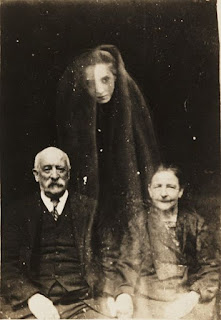Christmas Spirits: Ghosts in the Time of Dickens
By Shannon Stockwell
In the 1800s, a strange and spooky
fad took the Western world by storm: talking to ghosts. Mediums were in high
demand as people organized séances to contact the dead. The craze, known as
spiritualism, had a few different causes. It came from improvements in
communication technology—if you could send near-immediate telegraphs to your
cousin several hundred miles away, perhaps it wasn’t such a stretch to imagine
you could contact your mother from beyond the grave. It came from an increase
in hiring household staff; seen but never heard, a servant’s presence may have seemed
rather ghostly to those living there. And it may have even been related to
hallucinations brought on by carbon monoxide coming from the gas lamps popular
at the time.
The upshot of all this was “a
progressive internalization of horror,” according to author Dr. Andrew Smith.
This proved to be irresistible psychology for many nineteenth-century Western
authors, and thanks to the rise of the periodical press, spooky stories were
able to flourish. Of course, there had always been spirits throughout the
history of English literature, but their primary function had been to further
the plot—take, for example, the ghost of the titular character’s father in
Shakespeare’s Hamlet. Now, the
phantoms had a new purpose: terrify the reader.
 |
| Couple with a young female spirit. Photo courtesy Wikimedia Commons. |
In Victorian England, ghost stories
were especially popular around Christmastime. These yuletide tales of specters
and spirits tended to take on a less spooky tone, however—the intention wasn’t
necessarily to scare. Instead, says Tara Moore in Victorian Christmas in Print, “supernatural agents enter the
narrative to alter reality and . . . bring about a Christmas utopia of reunion
and spiritual redemption.” Charles Dickens’s A Christmas Carol was one of the most successful of these Yuletide ghost
stories, and while the spirits in it can be frightening, they are carefully constructed
to convince Ebenezer Scrooge to change his miserly ways.
For his part, Dickens tended toward
scientific explanations of “supernatural” events and blamed them on “a
disordered condition of the nerves or senses.” But he maintained a measure of
agnosticism, writing to a friend, “Don’t suppose I am so bold and arrogant as
to settle what can and what cannot be, after death.” He also joined the London
Ghost Club, where he participated in several séances. He remained unconvinced
of their legitimacy, believing that alcohol may have played more of a role than
anything truly supernatural: “The seer had a vision,” he said, “which nothing
but spirits could account for, and from which nothing but soda-water, or time,
is likely to have recovered him.”
This notion—that the senses are
easily affected by explainable physical circumstances—comes through in A Christmas Carol. After Scrooge questions
the reality of the first ghost, the spirit asks him why he doesn’t trust his
senses. Scrooge responds, “Because . . . a little thing affects them. A slight
disorder of the stomach makes them cheats. You may be an undigested bit of
beef, a blot of mustard, a crumb of cheese, a fragment of an underdone potato.
There’s more of gravy than of grave about you, whatever you are!”
But Dickens knew that, no matter
how much scientific reasoning one could come up with, the vision of a ghost was
still very real—and sometimes terrifying—to those who truly believed they saw
one. The monsters might come from within our own psychology, but that does not
mean we necessarily have the power to make the spirits go away. Scrooge
certainly does not, which he realizes as each of the four ghosts force him to
witness painful events from his past, present, and future. The inescapability
of the ghosts serves to make the story that much more frightening, and, 172
years later, that which Virginia Woolf calls “the strange human craving for the
pleasure of feeling afraid” keeps us coming back to A Christmas Carol again and again.

